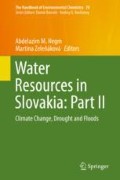Abstract
Drought by itself cannot be considered a disaster. However, if its impacts on local people, economies and the environment are severe and their ability to cope with and recover from it is difficult, it should be considered as a disaster. Droughts and floods are a recognizable category of natural risk. Hydrological assessments of drought impacts require detailed characteristics. We propose a new conceptual framework for drought identification in landscape with agricultural use. We described hydrological drought characteristics with impacts at the agricultural landscape and food security and the issues related to drought water management. In the past, the Slovak Republic was not considered a country immediately threatened with drought. The situation had changed at the turn of the millennium, especially after the extreme weather conditions in 2014 and also in 2015, when, for example, the historical minima were recorded.
Access this chapter
Tax calculation will be finalised at checkout
Purchases are for personal use only
References
Čimo J, Igaz D, Bárek V (2008) Hodnotenie sucha na základe agroklimatických a pôdnych faktorov. In: Rožnovský J, Litschmann T (eds) Bioklimatologické aspekty hodnocení procesů v krajině, Mikulov 9. 11.9.2008, ISBN 978-80-86690-55-1
Húska D, Jurík Ľ, Tátošová L, Šinka K, Jakabovičová J (2017) Cultural landscape, floods and remote sensing. J Ecol Eng 18(3):31–36
Jurík Ľ, Húska D, Halászová K, Bandlerová A (2015) Small water reservoirs—sources of water or problems? J Ecol Eng 16(4):22–28
Fekete V (2013) Výhľadová VHB množstva a kvality povrchovej vody k časovému horizontu 2021 vrátane prehodnotenia výhľadových vodných nádrží. VÚVH Bratislava
SHMU (2018) http://www.shmu.sk/sk/?page=1784&id=
SHMU (2018) http://www.shmu.sk/sk/?page=1604
https://www.news.iastate.edu/news/2018/01/03/planttattoosensors
Hettiarachchi H, Reza A (eds) (2016) Safe use of wastewater in agriculture: good practice examples cUNU-FLORES
Wilhite DA (1991) Drought planning: a process for state government. Water Resour Bull 27(1):29–38
Freire-González J, Decker C, Hall JW (2017) The economic impacts of droughts: a framework for analysis. Ecol Econ 132:196–204. https://doi.org/10.1016
WMO (2006) Drought monitoring and early warning: concepts, progress and future challenges. http://www.wmo.int/pages/publications/showcase/documents/1006_E.pdf
Ding Y, Hayes MJ, Widhalm M (2010) Measuring economic impacts of drought: a review and discussion. Papers in Natural Resources 196:1–23
Novák V (2012) Evapotranspiration in the soil–plant–atmosphere system. Springer Science + Business Media, Dordrecht. 253 p
Van Loon AF (2015) Hydrological drought explained. WIREs Water 2:359–392. https://doi.org/10.1002/wat2.1085
Wanders N, Wada Y (2015) Human and climate impacts on the 21st-century hydrological drought. J Hydrol 526:208–220
Ondráček P (2014) Vyhodnocení trendů k vysychavosti vodních toků: Projekt TA ČR BIOSUCHO a databáze SALAMANDER—Hydrogeologické hodnocení povodí. Zpráva. Brno, 2014, 16 s
Meyer WS, Kondrlová E, Koerber GR (2015) Evaporation of perennial semi-arid woodland in southeastern Australia is adapted for irregular but common dry periods. Hydrol Process 29:3714–3726
Van Loon AF, Stahl K, Di Baldassarre G, Clark J, Rangecroft S, Wanders N, Gleeson T, Van Dijk AIJM, Tallaksen LM, Hannaford J, Uijlenhoet R, Teuling AJ, Hannah DM, Sheffield J, Svoboda M, Verbeiren B, Wagener T, Van Lanen HAJ (2016) Drought in a human-modified world: reframing drought definitions, understanding, and analysis approaches. Hydrol Earth Syst Sci 20:3631–3650. https://www.hydrol-earth-syst-sci.net/20/3631/2016/hess-20-3631-2016.pdf
Newman JE, Oliver JE (2005) Palmer index/Palmer drought severity index. In: Oliver JE (ed) Encyclopedia of world climatology. Springer, Dordrecht, The Netherlands, pp 571–573
Urquijo J, Pereira D, Dias S, De Stefano L (2016) A methodology to assess drought management as applied to six European case studies. Int J Water Resour Dev. https://doi.org/10.1080/07900627.2016.1174106
Kellner O, Niyogi D (2014) Forages and Pastures symposium: assessing drought vulnerability of agricultural production systems in context of the 2012 drought. J Anim Sci 92(7):2811–2822. https://doi.org/10.2527/jas.2013-7496. https://www.animalsciencepublications.org/publications/jas/articles/92/7/2811
National Drought Mitigation Center, University of Nebraska-Lincoln, USA. http://drought.unl.edu/DroughtBasics/TypesofDrought.aspx
Lapin M, Melo M (2004) Methods of climate change scenarios projection in Slovakia and selected results. J Hydrol Hydromechan 52(4):224–238
Weiskel PK, Vogel RM, Steeves PA, Desimone LA, Zarriello PJ, Ries KG (2007) Water-use regimes: characterizing direct human interaction with hydrologic systems. Water Resour Res 43. https://doi.org/10.1029/2006WR005062
Novák V (1995) Evapotranspiration and its estimation. Veda, Bratislava. 260 p
Bárek V, Halaj P, Igaz D (2009) The influence of climate change on water demands for irrigation of special plants and vegetables in Slovakia. In: Bioclimatology and natural hazards. Springer, Dordrecht, pp 271–282
Benetin J, Šoltész A (1988) Hydrologické charakteristiky vodného režimu pôd a ich výpočet. In: Agromelio. ČSVTS, Nitra, pp 12–20
Gomboš MJ, Ivančo R, Mati D, Pavelková D (1999) Výsledky meraní pôdnej vlhkosti v ťažkých pôdach na Východoslovenskej nížine. In: III. Zborník z konferencie “Vplyv antropogénnej činnosti na vodný režim nížinného územia”. ÚH SAV Bratislava, Michalovce, s. 258–261
Tárník A, Tárníková M (2017) Analysis of the development of available soil water storage in the Nitra river catchment. IOP Conf Ser Mater Sci Eng 245:9
Orfánus T (2005) Spatial Assessment of Soil Drought Indicators at Regional Scale: Hydrolimits andSoil Water Storage Capacity in Záhorská nížina Lowland. J Hydrol Hydromechan 53(3):164–176
Tate EL, Gustard A (2000) Drought definition: a hydrological perspective. In: Vogt JV, Somma F (eds) Drought and drought mitigation in Europe. Kluwer Academic Publishers, Dordrecht, The Netherlands, pp 23–48
Lapin M, Faško P, Kveták Š (1988) Metodický predpis 3-09-1/1. Klimatické normály. SHMÚ, Bratislava, 25 pp
European Environmental Agency (2012) Climate change, impacts and vulnerability in Europe 2012. An Indicator Based Report. EEA Report No. 12/2012. EEA, Copenhagen, 300 pp
Acknowledgements
This chapter was supported by the following grants and projects:
-
APVV-16-0278: Use of hydromelioration structures for mitigation of the negative extreme hydrological phenomena effects and their impacts on the quality of water bodies in agricultural landscapes
-
KEGA 028SPU-4/2017: Monitoring of elements of environment—practical course
Author information
Authors and Affiliations
Corresponding author
Editor information
Editors and Affiliations
Rights and permissions
Copyright information
© 2018 Springer International Publishing AG
About this chapter
Cite this chapter
Jurík, Ľ., Kaletová, T. (2018). Drought as Stress for Plants, Irrigation and Climatic Changes. In: Negm, A., Zeleňáková, M. (eds) Water Resources in Slovakia: Part II. The Handbook of Environmental Chemistry, vol 70. Springer, Cham. https://doi.org/10.1007/698_2018_271
Download citation
DOI: https://doi.org/10.1007/698_2018_271
Published:
Publisher Name: Springer, Cham
Print ISBN: 978-3-319-92864-7
Online ISBN: 978-3-319-92865-4
eBook Packages: Earth and Environmental ScienceEarth and Environmental Science (R0)

